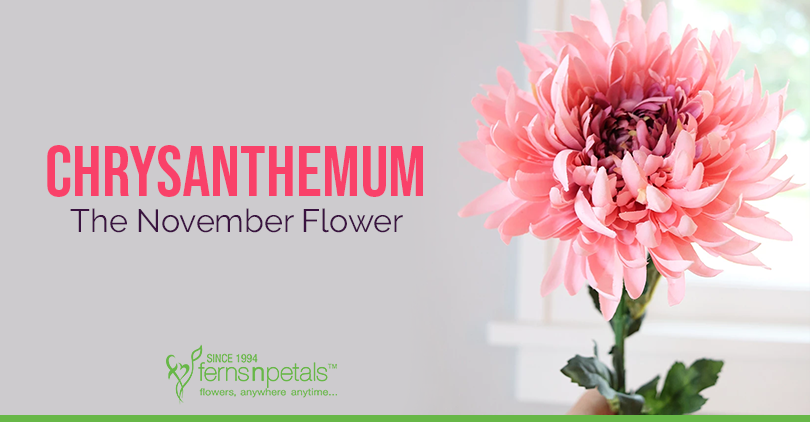Flowers play a crucial role in our lives. They elevate good mood, spread happiness, and are used for many medicinal and cosmetic purposes. One such amazing flower is chrysanthemum which is the official flower for November. It belongs to the family of Asteraceae and is native to Asia and North-Eastern Europe. The word chrysanthemum is derived from two Greek words –
chrysos and
anthemon meaning gold and flower respectively. These bushy and beautiful flowers were first cultivated in China and that too in the 15th century. Chrysanthemums, in general, symbolize long-lasting friendship, family support, cheerfulness, enduring life & rebirth, loyalty, devotion, and enthusiasm.
Read below and know many other things about this beautiful bloom:
- There are 40 different species of chrysanthemums.
- The cultivation of chrysanthemums started in China first and it was brought to Japan by the Buddhist monks. By the 17th century, it entered the western world. It entered the American horticultural space in 1798.
- The chrysanthemum was adopted as the official flower of the city of Chicago by Mayor Richard J. Daley in 1966. It is also the official flower of the city of Salinas, California.
- The best thing about chrysanthemums is that they can grow in any type of soil. They just need great sunny weather for a mind-blowing result.
- Chrysanthemum is the flower for November and that suggests it is a flower that symbolizes the beginning of winter season that is joyful.
- In various cultures – the significance of this flower is different. Chrysanthemums are the official Mother’s Day flower in Australia. In the USA, this flower stands for cheerfulness and positivity. In ancient times, the Victorians used to attach friendship with chrysanthemums. In China, this flower holds a significant place as it is called one of the Four Gentlemen in Chinese culture.
- The Four Gentlemen of China are plum blossom, orchid, bamboo, and chrysanthemum. Each of them denotes a season. Chrysanthemum represents the fall.
- Tao Qian – an eminent Chinese poet said chrysanthemums represent nobility.
- Do you know that a chrysanthemum festival is held each year in Tongxiang, near Hangzhou, China?
- Chrysanthemums also hugely inspire poets and painters. Numerous artworks in China are dedicated to chrysanthemums or inspired by them.
- Do you know that the fruit of the chrysanthemum is called ribbed achene?
- In Chinese cuisine, these chrysanthemums are used profusely. This flower comes with great medical properties. The leaves are boiled and used as food while the flowers are used to make broth or soups which spreads an enticing aroma.
- It is interesting to learn that chrysanthemum contains a chemical called Pyrethrum which helps repel most bugs naturally. That’s why this flower is used as insecticides also.
- Do you know that Israel has named a new fast-growing Chrysanthemum flowers after Narendra Modi? Narendra Modi is the Prime Minister of India and Israel named the chrysanthemum after Narendra Modi as a special gesture to mark the first visit of an Indian head of state to the Jewish nation.
- The Japanese also used chrysanthemums to garnish sashimi.
- Almost all over Asia, there is the use of chrysanthemum tea which helps in relieving stress, headache, sore throat, dizziness, swelling, high blood pressure, diabetes (type 2), and fever. It is also believed to protect against prostate cancer.
- Gukhwaju is the name of a special rice wine that is made in Korea. The specialty of this wine is that it is flavored with chrysanthemum flowers.
- Most species of chrysanthemum bloom from August to November.
- As per the research conducted by NASA, the chrysanthemum flowering plant is one of the major plants that help in the reduction of air pollution.
- Feng Shui says that Chrysanthemums bring laughter and happiness to the home.
Also Read: Know More About Marigold: The October Flower
Enjoy the view of charming chrysanthemums this November and share this information with your friends.





